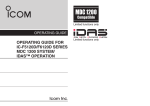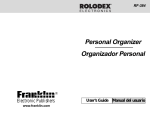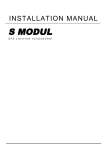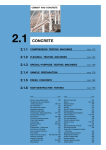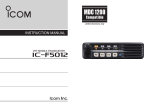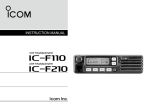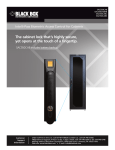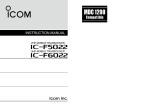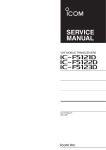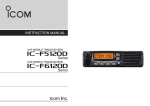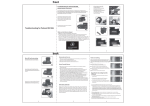Download dPMR OPERATION
Transcript
OPERATING GUIDE OPERATING GUIDE FOR IC-F5122D IC-F6122D IDAS™ dPMR™ OPERATION IMPORTANT Thank you for purchasing this Icom transceiver. The digital Private Mobile Radio (dPMR) system functions are built into your IC-F5122D/F6122D transceiver. READ ALL INSTRUCTIONS carefully and completely before using the transceiver. SAVE THIS OPERATING GUIDE — This guide contains important operating instructions for: • IC-F5122D vhf dpmr mobile transceiver • IC-F6122D uhf dpmr mobile transceiver i Icom, Icom Inc. and the Icom logo are registered trademarks of Icom Incorporated (Japan) in Japan, the United States, the United Kingdom, Germany, France, Spain, Russia and/or other countries. IDAS and IDAS logo are trademarks of Icom Incorporated (Japan). dPMR and the dPMR logo are trademarks of the dPMR MoU Association. All other products or brands are registered trademarks or trademarks of their respective holders. INFORMATION: The 10-keypad of the optional microphones have only the DTMF code transmitting capability, so you cannot input any ID or message with these microphones. TABLE OF CONTENTS IMPORTANT........................................................................... i TABLE OF CONTENTS......................................................... ii 1 PREPARATION............................................................1–2 ■ Programmable function keys.........................................1 2 dPMR OPERATION....................................................3–10 ■ dPMR operation............................................................3 ■ Receiving a call.............................................................3 ■ Transmitting a call..........................................................7 ■ Position data transmission............................................9 ■ Status message transmission.......................................9 ■ Horn output.................................................................10 ■ Printer connection.......................................................10 ii 1 PREPARATION ■ Programmable function keys The following functions can be assigned to [UP], [DOWN], [P0], [P1], [P2] and [P3] programmable function keys. Consult your Icom dealer or system operator for details concerning your transceiver’s programming. If the programmable function names are bracketed in the following explanations, the specific key is used to activate the function. D For dPMR operation The following key functions are required for the operation. dPMR BUTTON ➥Push to enter the ID selection mode. • Push [CH Up] or [CH Down] to select a desired Individual or Talkgroup ID. ➥While in the ID selection mode, push to enter the application selection mode. •P ush [CH Up] or [CH Down] to select a desired application from “STAT,” and “MSG.” ➥Push to enter the message selection mode. •P ush [CH Up] or [CH Down] to select a desired message. ➥While in the application selection mode, push to return to the stand-by mode. CLEAR After communication is finished, push this key to send a ‘Disconnect’ signal to terminate the connection. Depending on the preprogrammed settings, the Priority A channel is automatically selected after a ‘Disconnect’ signal terminates a connection. 1 PREPARATION 1 D dPMR operations D Additional key functions The following key functions are useful for the dPMR operation. • dPMR operations The following key functions are recommended for the dPMR operation, and function as described below. STATUS UP, STATUS DOWN ➥Push to select a status message. ➥When the automatic scroll function is activated, push to cancel it, if desired. ➥When an SDM that includes more than 8 characters is displayed, push to manually scroll the message. STATUS ➥Push to enter the status message selection mode. • Push [CH Up] or [CH Down] to select a desired message. ➥Hold down for 1 second to transmit the last selected status message. MESSAGE ➥Push to enter the SDM selection mode. • Push [CH Up] or [CH Down] to select a desired SDM. ➥While in the SDM selection mode, hold down for 1 second to transmit the last selected SDM. CALL On a digital channel, push to transmit a dPMR call. Depending on the preprogrammed settings, pushing [PTT] makes a call in the same way as using [Call]. Moreover, when you keep holding down [PTT] after receiving an acknowledgement, you can start a conversation without pushing it again. TX CODE ENTER Push to enter the ID code edit mode, and then set a desired ID code. (p. 7) MONITOR (AUDIBLE) After communication is finished, push this key to send a ‘Clear down’ signal to terminate the connection. Depending on the preprogrammed settings, the Priority A channel is automatically selected after a ‘Clear down’ signal terminates a connection. 1 2 3 4 5 6 7 8 9 10 11 12 13 14 15 16 2 2 dPMR OPERATION ■ dPMR operation D Receiving a Group call The IC-F5122D and IC-F6122D provide digital Private Mobile Radio (dPMR) operation that meets the 6.25 kHz bandwidth requirements for narrow band operation. This increases efficiency of channel allocation and use of the spectrum. ■ Receiving a call D Receiving an Individual call qWhen a Group call is received: • Mute is released. • While receiving the signal, either the calling station or Talkgroup ID name (or code) can be displayed, depending on the preprogramming. • When an All Call is received, “ALL CALL” is displayed. The calling station or Talkgroup ID name qWhen an Individual call is received: • Beeps sound. •“ ” appears and the mute is released. • “ ” appears or blinks, depending on the preprogrammed settings. • The calling station’s ID (or name) blinks. wWhile holding down [PTT], speak into the microphone at your normal voice level. NOTE: Only one station is allowed to speak at the same time. eRelease [PTT] to receive. The calling station ID name wWhile holding down [PTT], speak into the microphone at your normal voice level. eRelease [PTT] to receive. Continued on the next page 3 dPMR OPERATION D Receiving a status message D Receiving an SDM qWhen a status message is received: qWhen an SDM is received: • Beeps sound. • The calling station or Talkgroup ID name (or code) and the status message alternately appear. 2 • Beeps sound. • The calling station’s ID (or name) and the SDM are displayed. The message The status message The calling station or Talkgroup ID name wTo clear the ID and message display, push [PTT], turn OFF the power or change the channel. The calling station or Talkgroup ID name OTE: When the SDM includes more than 8 characN ters, it automatically scrolls. • Push [Status Up] or [Status Down] to stop scrolling, or manually scroll the message. Scrolls 1 2 3 4 5 6 7 8 9 10 11 12 13 14 15 16 wAfter a specified time period has passed, the transceiver will return to standby. 4 2 dPMR OPERATION D Receiving a Stun, Kill or Revive D Receiving a Status Polling call If an Individual call with a Stun or Kill command is received, the transceiver will display “SORRY” and you can not receive* or transmit. If a Status Polling call is received, the transceiver will automatically transmit its current status. * Depending on the received Stun command setting. Revive signals can always be received. ➥When a Stun command is received: • The transceiver cannot be operated until an Individual call a Revive command is received, or you enter a password. D Receiving an Ambience Listening call If an Individual call with an Ambience Listening command is received from a specified station, the transceiver will automatically transmit its microphone audio. • The HM-148G or HM-152/152T hand microphone is required. NOTE: If the transceiver receives an Ambience Listening command from a station other than the specified one, the call will be ignored, and the transceiver will not transmit its microphone audio. ➥When a Kill command is received: • The transceiver cannot be operated until data cloning is performed. Ask your dealer for details. NOTE: Depending on the preprogramming, the transceiver can ignore the Stun, Revive and Kill commands that are from a non-specified station. D Receiving an Emergency call qWhen an emergency call is received: • Beeps sound. • The state of the backlight depends on the Backlight setting in the User Set mode. When “LIGT AUT” is selected, the backlight turns ON for the preprogrammed time period. (Auto Backlight Timer) wTo clear the beep, ID and message display, turn OFF the power or change the channel. 5 dPMR OPERATION 2 D Displaying the received call log D Talk back function If activated, the log stores received calls into the transceiver’s memory. Up to 10 calls can be stored, and the oldest call record is erased when an 11th call is received. However, once the transceiver is turned OFF, the log is erased. The Individual voice call, Status call and Message call are stored. The Talk Back function allows you to select the same call mode (Analog or Digital) as the received call. If the received call is a digital signal, the Talk Back function is activated for Voice and Emergency calls, and depending on the preprogrammed settings, also for status messages and SDM. qPush [dPMR Button] twice to enter the application selection mode. wPush [CH Up] or [CH Down] to select “CALL LOG.” ePush [dPMR Button] again to display the call log information. When log information is displayed The calling station ID name appears. When there is no log information When the channel type is “Mixed-Digital” After receiving an analog signal, “ANALOG” is displayed during the Talk Back timer period, depending on the preprogrammed settings. When [PTT] is pushed before or during the Talk Back timer period, you can transmit an analog signal. When the channel type is “Mixed-Analog,” “Mixed-Digital” or “Digital” After receiving a digital signal, the calling station’s ID or the Talkgroup ID is displayed until receiving a ‘Disconnect’ signal, depending on the preprogrammed settings. Even on a “Mixed-Analog” channel, when [PTT] is pushed before receiving a ‘Disconnect’ signal, the Talk Back function allows the transceiver to transmit a digital signal to the ID. NOTE: When this function is not activated, the transceiver always transmits analog signals on “Mixed-Analog” channels, and digital signals on “Mixed-Digital” channels. rPush [CH Up] or [CH Down] to select the desired call. yHold down [PTT] to send a voice call. 1 2 3 4 5 6 7 8 9 10 11 12 13 14 15 16 • On these channels, the transceiver can receive both analog and digital signals, regardless of the Talk Back function. • A voice call can be made with the logged station. 6 2 dPMR OPERATION ■ Transmitting a call dPMR operation allows you to make a call to a specific station (Individual call) or to a specific group (Talkgroup call). Other digital mode transceivers on the channel will not hear a call that does not match their Individual or Talkgroup ID. D Transmitting a Voice Call qPush [dPMR Button] to enter the ID selection mode. • The preprogrammed ID name is displayed. • When an ID name is not programmed, ID code is displayed. • The primary ID can be preset to display first. wPush [CH Up] or [CH Down] to select a desired Individual ID or Talkgroup ID. • The IDs can be edited within the allowable digits. See the column to the right for details. • Editing an ID If the transceiver has a key assigned to the TX Code Enter function, you can edit an ID within the allowable digits. qPush [TX Code Enter] to enter the ID edit mode. • The digit to be edited blinks. wPush [TX Code Enter] to select a desired digit to be edited. ePush [CH Up] or [CH Down] to select a desired number. rPush [TX Code Enter] to set. The digit to the right will automatically blink. tRepeat step e and r to input all allowable digits. yAfter editing, push [TX Code Enter] to store the setting. • The transceiver returns to the stand-by mode. NOTE: Changing the channel or turning OFF the transceiver discards the new ID, and returns the original one. * This illustration shows an Individual type call. eHold down [PTT], then speak into the microphone. rRelease [PTT] to receive. 7 dPMR OPERATION 2 D Transmitting an SDM D Transmitting an Emergency Call You can send a preprogrammed SDM to an individual station or to group stations. The transceiver has 10 memories to store messages. When [Emergency] (described in the instruction manual) is held down for the specified time period, the emergency signal is transmitted once or repeatedly* on the emergency channel. When no emergency channel is specified, the signal is transmitted on the operating channel. qPush [dPMR Button] to enter the ID selection mode. • The preprogrammed ID is displayed. wPush [CH Up] or [CH Down] to select a desired Individual ID or Talkgroup ID. • The IDs can be edited within the allowable digits. See page 7 for details. ePush [dPMR Button] again to enter the application selection mode. • “STAT” is displayed. rPush [CH Up] or [CH Down] to select “MSG.” tPush [dPMR Button] again to enter the SDM selection mode. • The preprogrammed SDM is displayed. yPush [CH Up] or [CH Down] to select a desired SDM. uPush [Call] to transmit the SDM to the selected station or talkgroup. • “WAIT” is displayed while transmitting. • “OK” is displayed when an acknowledgement is received. • “FAILED” is displayed when no acknowledgment is received. iAfter a specified time period, the transceiver will return to the stand-by mode. *When the Repeat Cancel function is ON, the transceiver cancels repeat calling after receiving an acknowledgement. When the Repeat Cancel function is OFF, the transceiver continues to call according to the number of repeat cycles, even after receiving an acknowledgement. Individual or Talkgroup call types of emergency calls can be preset. If the call type is not preset, the default or selected call type is used. If you want to cancel the emergency call, hold down [Emergency] again before transmitting the call. The emergency call can be transmitted without sounding beeps or changing the LCD display, depending on the preprogramming. (Silent operation) The transceiver can also be programmed to keep the microphone open during an emergency call, allowing other stations to monitor the situation. 1 2 3 4 5 6 7 8 9 10 11 12 13 14 15 16 Ask your dealer for details. 8 2 dPMR OPERATION IMPORTANT: Setting an individual emergency channel is recommended for dependable emergency call operation. NOTE: When the Digital Request Ack function is activated, the transceiver transmits an emergency call with a request to send back an acknowledgment. ■ Position data transmission When a GPS receiver is connected to the transceiver, the position (longitude and latitude) data can be automatically transmitted: • When the GPS request status message is received • After sending a voice message - Set the ‘Send with Log-off’ item to ‘Enable.’ • After sending a status message - Set the ‘Send with Status Call’ item to ‘Enable.’ • After sending a message - Set the ‘Send with SDM Call’ item to ‘Enable.’ • After sending an Emergency call - Set the ‘Send with Emergency’ item to ‘Enable.’ Ask your dealer or system operator for connection details. ■ Status message transmission A status message can be automatically transmitted. A status message is transmitted: • When the transceiver is turned ON or turned OFF - Set a status message to be transmitted in ‘Power ON Status’ or ‘Power OFF Status’ item, respectively. - Set the target station ID in ‘Power Status ID.’ • After sending a voice message - Set the ‘Send with Log-off’ item to ‘Enable.’ - Set a status message to be transmitted in the ‘Send Status Number’ item. 9 dPMR OPERARATION ■ Horn output The automatic honking function can be used when a horn is connected to the transceiver through the optional ACC cable OPC-1939 (D-Sub 15-pin) or OPC-2078 (D-Sub 25-pin). When a status message is received, the transceiver sounds the vehicle’s horn for the specified time period to inform you that a status message has being received. This function is convenient when the operator is away from the transceiver. Ask your dealer or system operator, or refer to the IC-F5122D/ F6122D service manual for connection and setting details. ■ Printer connection When the printer is connected to the transceiver through the OPC-2078, the received SDM content and the called station ID can be printed out. Ask your dealer or system operator for connection details. 2 1 2 3 4 5 6 7 8 9 10 11 12 13 14 15 16 10 A-7089-1EU © 2013 Icom Inc. 1-1-32 Kamiminami, Hirano-ku, Osaka 547-0003, Japan














